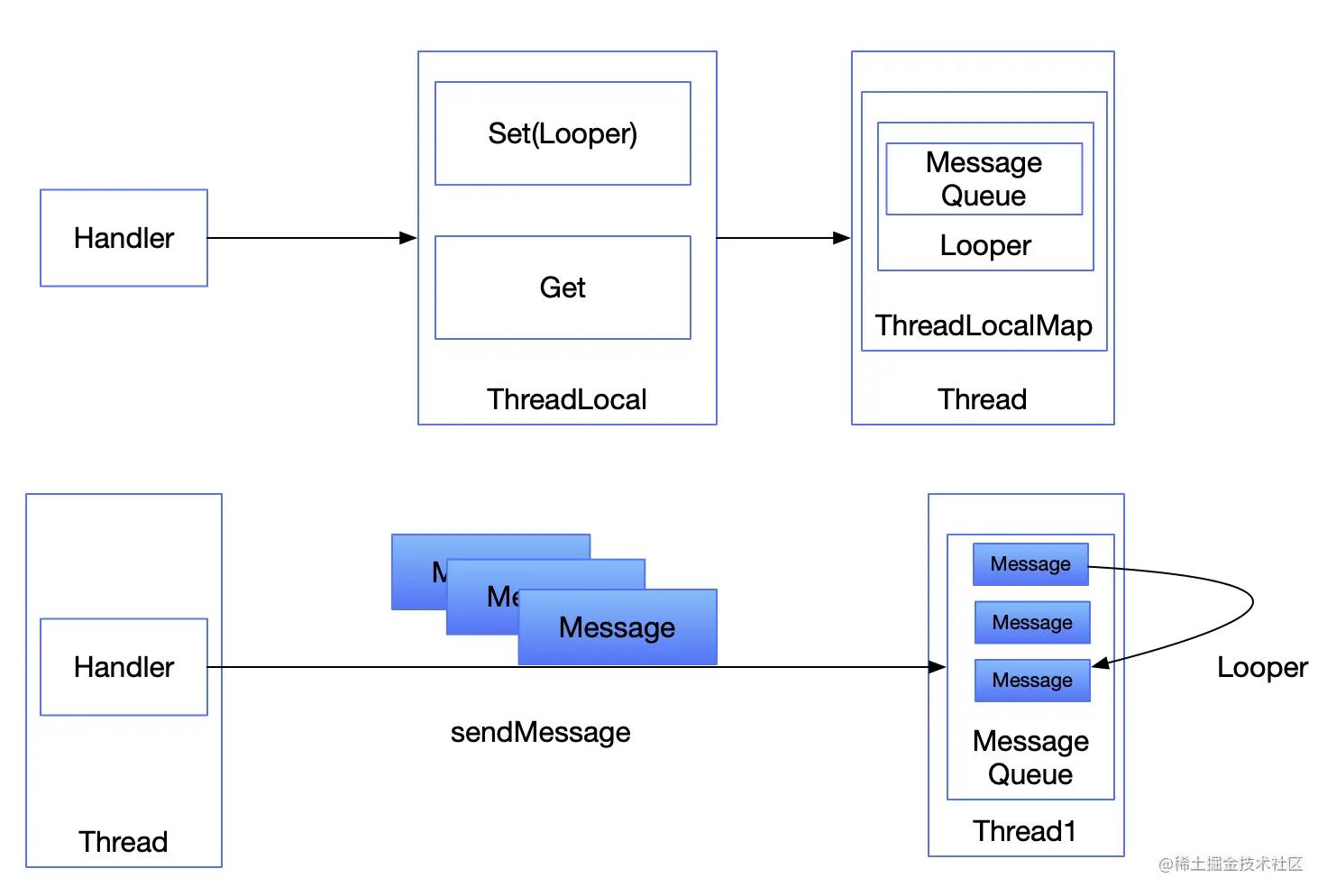Android Handler架构思考
Posted 冬天的毛毛雨
tags:
篇首语:本文由小常识网(cha138.com)小编为大家整理,主要介绍了Android Handler架构思考相关的知识,希望对你有一定的参考价值。
作者:八道
前言
写这篇文章不是为了分析Handler怎么使用,目的是想从设计的角度来看Handler的演进过程,以及为什么会出现Looper,MessageQueue,Handler,Message这四个类。
一.线程通信的本质?
线程区别于进程的主要因素在于,线程之间是共享内存的。在android系统中,堆中的对象可以被所有线程访问。因此无论是哪种线程通信方式,考虑到性能问题,一定会选用持有对方线程的某个对象来实现通信。
1.1 AsyncTask
public AsyncTask(@Nullable Looper callbackLooper)
mHandler = callbackLooper == null || callbackLooper == Looper.getMainLooper()
? getMainHandler()
: new Handler(callbackLooper);
mWorker = new WorkerRunnable<Params, Result>()
public Result call() throws Exception
mTaskInvoked.set(true);
Result result = null;
try
Process.setThreadPriority(Process.THREAD_PRIORITY_BACKGROUND);
//noinspection unchecked
result = doInBackground(mParams);
Binder.flushPendingCommands();
catch (Throwable tr)
mCancelled.set(true);
throw tr;
finally
postResult(result);
return result;
;
mFuture = new FutureTask<Result>(mWorker)
@Override
protected void done()
try
postResultIfNotInvoked(get());
catch (InterruptedException e)
android.util.Log.w(LOG_TAG, e);
catch (ExecutionException e)
throw new RuntimeException("An error occurred while executing doInBackground()",
e.getCause());
catch (CancellationException e)
postResultIfNotInvoked(null);
;
private Result postResult(Result result)
@SuppressWarnings("unchecked")
Message message = getHandler().obtainMessage(MESSAGE_POST_RESULT,
new AsyncTaskResult<Result>(this, result));
message.sendToTarget();
return result;
从用法可以看出,AsyncTask也是间接通过handler机制实现从当前线程给Looper所对应线程发送消息的,如果不传,默认选的就是主线程的Looper。
1.2 Handler
借助ThreadLocal获取thread的Looper,传输message进行通信。本质上也是持有对象线程的Looper对象。
public Handler(@Nullable Callback callback, boolean async)
if (FIND_POTENTIAL_LEAKS)
final Class<? extends Handler> klass = getClass();
if ((klass.isAnonymousClass() || klass.isMemberClass() || klass.isLocalClass()) &&
(klass.getModifiers() & Modifier.STATIC) == 0)
Log.w(TAG, "The following Handler class should be static or leaks might occur: " +
klass.getCanonicalName());
mLooper = Looper.myLooper();
if (mLooper == null)
throw new RuntimeException(
"Can't create handler inside thread " + Thread.currentThread()
+ " that has not called Looper.prepare()");
mQueue = mLooper.mQueue;
mCallback = callback;
mAsynchronous = async;
public final boolean post(@NonNull Runnable r)
return sendMessageDelayed(getPostMessage(r), 0);
public boolean sendMessageAtTime(@NonNull Message msg, long uptimeMillis)
MessageQueue queue = mQueue;
if (queue == null)
RuntimeException e = new RuntimeException(
this + " sendMessageAtTime() called with no mQueue");
Log.w("Looper", e.getMessage(), e);
return false;
return enqueueMessage(queue, msg, uptimeMillis);
1.3 View.post(Runnable)
public boolean post(Runnable action)
final AttachInfo attachInfo = mAttachInfo;
if (attachInfo != null)
return attachInfo.mHandler.post(action);
// Postpone the runnable until we know on which thread it needs to run.
// Assume that the runnable will be successfully placed after attach.
getRunQueue().post(action);
return true;
getRunQueue().post(action)仅仅是在没有attachToWindow之前缓存了Runnable到数组中
private HandlerAction[] mActions;
public void postDelayed(Runnable action, long delayMillis)
final HandlerAction handlerAction = new HandlerAction(action, delayMillis);
synchronized (this)
if (mActions == null)
mActions = new HandlerAction[4];
mActions = GrowingArrayUtils.append(mActions, mCount, handlerAction);
mCount++;
等到attachToWindow时执行,因此本质上也是handler机制进行通信。
void dispatchAttachedToWindow(AttachInfo info, int visibility)
mAttachInfo = info;
....
// Transfer all pending runnables.
if (mRunQueue != null)
mRunQueue.executeActions(info.mHandler);
mRunQueue = null;
....
1.4 runOnUiThread
public final void runOnUiThread(Runnable action)
if (Thread.currentThread() != mUiThread)
mHandler.post(action);
else
action.run();
通过获取UIThread的handler来通信。
从以上分析可以看出,android系统的四种常见通信方式本质上都是通过Handler技术进行通信。
二.handler解决什么问题?
handler解决线程通信问题,以及线程切换问题。本质上还是共享内存,通过持有其他线程的Looper来发送消息。
我们常提的Handler技术通常包括以下四部分
- Handler
- Looper
- MessageQueue
- Message
三.从架构的演进来看Handler
3.1 原始的线程通信
String msg = "hello world";
Thread thread = new Thread()
@Override
public void run()
super.run();
System.out.println(msg);
;
thread.start();
Thread thread1 = new Thread()
@Override
public void run()
super.run();
System.out.println(msg);
;
thread1.start();
3.2 结构化数据支持
为了发送结构化数据,因此设计了Message
Message msg = new Message();
Thread thread = new Thread()
@Override
public void run()
super.run();
msg.content = "hello";
System.out.println(msg);
;
thread.start();
Thread thread1 = new Thread()
@Override
public void run()
super.run();
System.out.println(msg);
;
thread1.start();
3.3 持续通信支持
Message msg = new Message();
Thread thread = new Thread()
@Override
public void run()
for (;;)
msg.content = "hello";
;
thread.start();
Thread thread1 = new Thread()
@Override
public void run()
super.run();
for (;;)
System.out.println(msg.content);
;
thread1.start();
通过无限for循环阻塞线程,Handler中对应的是Looper。
3.4 线程切换支持
上述方法都只能是thread1接受改变,而无法通知thread。因此设计了Handler, 同时封装了发送和接受消息的方法.
class Message
String content = "123";
String from = "hch";
abstract class Handler
public void sendMessage(Message message)
handleMessage(message);
public abstract void handleMessage(Message message);
Message msg = new Message();
Thread thread = new Thread()
@Override
public void run()
for (;;)
try
Thread.sleep(1000);
catch (InterruptedException e)
e.printStackTrace();
msg.content = "hello";
if (handler != null)
handler.sendMessage(msg);
;
thread.start();
Thread thread1 = new Thread()
@Override
public void run()
super.run();
handler = new Handler()
@Override
public void handleMessage(Message message)
System.out.println(message.content);
;
;
thread1.start();
3.5 对于线程消息吞吐量的支持
abstract class Handler
BlockingDeque<Message> messageQueue = new LinkedBlockingDeque<>();
public void sendMessage(Message message)
messageQueue.add(message);
public abstract void handleMessage(Message message);
...
Thread thread1 = new Thread()
@Override
public void run()
super.run();
handler = new Handler()
@Override
public void handleMessage(Message message)
if (!handler.messageQueue.isEmpty())
System.out.println(messageQueue.pollFirst().content);
;
;
thread1.start();
增加消息队列MessageQueue来缓存消息,处理线程按顺序消费。形成典型的生产者消费者模型。
3.6 对于多线程的支持
上述模型最大的不便之后在于Handler的申明和使用,通信线程双方必须能够非常方便的获取到相同的Handler。
同时考虑到使用线程的便利性,我们不能限制Handler在某个固定的地方申明。如果能够非常方便的获取到对应线程的消息队列,然后往里面塞我们的消息,那该多么美好。
因此Looper和ThreadLocal闪亮登场。
- Looper抽象了无限循环的过程,并且将MessageQueue从Handler中移到Looper中。
- ThreadLocal将每个线程通过ThreadLocalMap将Looper与Thread绑定,保证能够通过任意Thread获取到对应的Looper对象,进而获取到Thread所需的关键MessageQueue.

//ThreadLocal获取Looper
public T get()
Thread t = Thread.currentThread();
ThreadLocalMap map = getMap(t);
if (map != null)
ThreadLocalMap.Entry e = map.getEntry(this);
if (e != null)
@SuppressWarnings("unchecked")
T result = (T)e.value;
return result;
return setInitialValue();
//Looper写入到ThreadLocal
private static void prepare(boolean quitAllowed)
if (sThreadLocal.get() != null)
throw new RuntimeException("Only one Looper may be created per thread");
sThreadLocal.set(new Looper(quitAllowed));
// 队列抽象
private Looper(boolean quitAllowed)
mQueue = new MessageQueue(quitAllowed);
mThread = Thread.currentThread();
//Handler获取Looper
public Handler(@Nullable Callback callback, boolean async)
if (FIND_POTENTIAL_LEAKS)
final Class<? extends Handler> klass = getClass();
if ((klass.isAnonymousClass() || klass.isMemberClass() || klass.isLocalClass()) &&
(klass.getModifiers() & Modifier.STATIC) == 0)
Log.w(TAG, "The following Handler class should be static or leaks might occur: " +
klass.getCanonicalName());
mLooper = Looper.myLooper();
if (mLooper == null)
throw new RuntimeException(
"Can't create handler inside thread " + Thread.currentThread()
+ " that has not called Looper.prepare()");
mQueue = mLooper.mQueue;
mCallback = callback;
mAsynchronous = async;
3.7 google对于Handler的无奈妥协
思考一个问题,由于Handler可以在任意位置定义,sendMessage到对应的线程可以通过线程对应的Looper–MessageQueue来执行,那handleMessage的时候,如何能找到对应的Handler来处理呢?我们可没有好的办法能直接检索到每个消息对应的Handler
两种解决思路
- 通过公共总线,比如定义Map<Message,Handler>来索引,这种方式要求map必须定义到所有的线程都能方便获取到的地方,比如可以定义为static
- 通过消息带Message来携带属性target到对应线程,当消息被消费后,可以通过Message来获得Handler.
第一种方式的问题比较明显,公共总线需要手动维护它的生命周期,google采用的是第二种方式。
private boolean enqueueMessage(以上是关于Android Handler架构思考的主要内容,如果未能解决你的问题,请参考以下文章